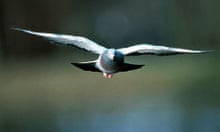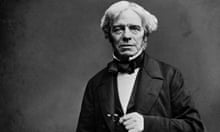Tiny biological compasses made from clumps of protein may help scores of animals, and potentially even humans, to find their way around, researchers say.
Scientists discovered the minuscule magnetic field sensors in fruit flies, but found that the same protein structures appeared in retinal cells in pigeons’ eyes. They can also form in butterfly, rat, whale and human cells.
The rod-like compasses align themselves with Earth’s geomagnetic field lines, leading researchers to propose that when they move, they act on neighbouring cell structures that feed information into the nervous system to create a broader direction-sensing system.
Professor Can Xie, who led the work at Peking University, said the compass might serve as a “universal mechanism for animal magnetoreception,” referring to the ability of a range of animals from butterflies and lobsters to bats and birds, to navigate with help from Earth’s magnetic field.
Whether the compasses have any bearing on human navigation is unknown, but the Peking team is investigating the possibility. “Human sense of direction is complicated,” said Xie. “However, I believe that magnetic sense plays a key role in explaining why some people have a good sense of direction.”
The idea that animals could sense Earth’s magnetic field was once widely dismissed, but the ability is now well established, at least among some species. The greatest mystery that remains is how the sensing is done.
One type of molecular compass, proposed by the biologist Klaus Schulten, senses geomagnetic field information through the bizarre quantum behaviour of electrons that are produced when light falls on retinal proteins called cryptochromes. But Xie argues that a compass based on cryptochromes alone is not enough to navigate.
By screening the fruit fly genome, the Chinese team discovered a protein they named MagR, which forms rod-like clumps with cryptochrome proteins. This MagR-cryptochrome cluster behaves like a sophisticated magnetic sensor that in principle can sense the direction, intensity or inclination of Earth’s magnetic field.
“The nanoscale biocompass has the tendency to align itself along geomagnetic field lines and to obtain navigation cues from a geomagnetic field,” said Xie. “We propose that any disturbance in this alignment may be captured by connected cellular machinery, which would channel information to the downstream neural system, forming the animal’s magnetic sense.”
In a series of follow-up experiments, the scientists show that MagR-cryptochrome compass can form in a range of species, including monarch butterflies, pigeons, more rats, minke whales and humans. Details are reported in the journal Nature Materials.
Xie said the discovery could go beyond understanding how animals navigate, and lead to new technologies that allow scientists to control cell processes and influence animal behaviour with magnetic fields.
Simon Benjamin, who studies quantum materials at Oxford University, said that evolution seemed to have found a number of ways to sense magnetic fields. “It seems plausible that the structure discovered in this paper is key to the fruit fly’s compass, and perhaps other species as well.”
He added that the finding was exciting even if the MagR-cryptochrome cluster was not one of nature’s biocompasses, because it could be used to develop new technologies. “There is a continual drive for cheaper, smaller, more robust, or more sensitive field sensors. They’re needed to enable a vast range of applications from mining survey systems to map navigation with mobile phones.”
“It has been well documented that cryptochromes, which are crucial to the compass proposed in this new paper, may harness significant quantum effects to convert the Earth’s weak magnetic field into a signal in the animal’s brain. This is a tantalising possibility since the new UK quantum technology hubs are focusing about a quarter of their £150M on sensor systems. It would be remarkable if we can learn some tricks from Mother Nature in this highly-advanced field of physics,” he added.









Comments (…)
Sign in or create your Guardian account to join the discussion